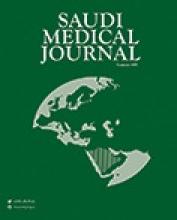Abstract
OBJECTIVE: To determine contemporary patterns of presentation and trends in the management and outcome of 51 newborn infants with intestinal atresia.
METHODS: We retrospectively reviewed 51 cases of intestinal atresia between January 1983 and February 2003. Clinical data included antenatal history, age, gender, weight, presenting symptoms and signs, diagnostic procedures, location and type of atresia, associated abnormalities, surgical treatment, associated problems, morbidity, mortality and plans of treatment.
RESULTS: Twenty children had duodenal obstruction, 24 had jejunoileal atresia, and 7 had colonic atresia. Approximately one-fourth of patients associated with duodenal atresia had preterm delivery and all patients with jejunoileal and colonic atresia were full term. Clinical features such as vomiting, abdominal distention, delayed meconium passage and jaundice were more frequent in jejunoileal atresia patients. Other associated organ anomalies particularly Down's syndrome were more frequent in duodenal atresia patients. A duodeno-duodenostomy was preferred in most of the patients with duodenal atresia and annular pancreas; duodenotomy and web excision for those with duodenal webs; and resection with end-to-end anastomosis for those with jejunoileal atresia. In all patients with colonic atresia, colostomy procedure was performed as the first step of surgery.
CONCLUSION: Experienced neonatal care and prompt total parenteral nutrition by placing central line during surgery may improve the outcome of such patients.
- Copyright: © Saudi Medical Journal
This is an open-access article distributed under the terms of the Creative Commons Attribution-Noncommercial-Share Alike 3.0 Unported, which permits unrestricted use, distribution, and reproduction in any medium, provided the original work is properly cited.






